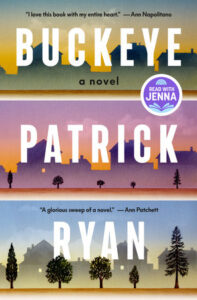
Patrick Ryan on the Secrets of the Omniscient Narrator
“I was the narrator’s manager, maybe. I was the narrator’s life coach. But I wasn’t the narrator.”
This first appeared in Lit Hub’s Craft of Writing newsletter—sign up here.
I started taking notes for the novel that became Buckeye (which is set almost entirely in a small town in Ohio) in 2016, and I thought it would be on the short side. I thought it would focus on two characters and take place over the course of a week or so. Not far into experimenting with early scenes, I started to glean that the story I wanted to tell was actually about two very distinct families, and three generations. Also, instead of a week of narrative time, I was looking at forty years.
The whole business felt tricky to me. I needed to figure out the best way to tell the story, yet I didn’t want to get too clear a sense of the story beforehand, because I wanted to leave room for discovery as I wrote. So, I needed to figure out the best way to tell a story I hadn’t figured out yet. My gut said should be a third person narrator. My gut also said it should be told from multiple perspectives, since no single perspective could adequately deliver the story I had in mind. The way I’d always written third person multiple-perspective narration in the past was to lay down a section break each time the perspective changed to a different character. If I stuck to that for Buckeye, I was going to need a hell of a lot of section breaks.
Don’t get me wrong—I love section breaks. Whenever I teach, I tell students, Section breaks are your friend. They can be useful to ratchet up tension, or nail a moment, or make a question echo in the reader’s mind, or just give the reader—and the writer—a breather. But I’d noticed in my own work that, because of my approach, whole scenes tended to get plugged into one perspective. (It wasn’t too often that I wasn’t interested in dropping a section break into the middle of a scene.)
Wouldn’t it be nice, I thought, to be one of those writers who could tell this whole story with one narrative voice that moved from character to character, strategically and smoothly—like the world’s tiniest and most efficient drone? What’s it like to be able to do that? What’s it like to be one of those writers? Because, I thought, in someone else’s hands, this could be a really interesting third-person-omniscient-narrated novel.
Having spent several months taking notes, by then, and having gotten a sense of all the characters, I actually thought that about my own idea. I actually wished it into someone else’s hands. How ridiculous is that?
Pretty goddamned ridiculous.
*
For once in my writing life, I decided to give it a try. I told myself that if I could establish the narrator’s ability to move into different perspectives within the first three pages of Chapter One, that would function like a contract with the reader I would then be obliged to honor. A whack-a-doodle approach, maybe, but nothing calls me to action more reliably than a sense of obligation. By that point, I’d written the first paragraph, introducing the reader to one of the main characters, a boy named Cal Jenkins, who’s born in 1920 and has uneven legs that kids make fun of in grade school, and I’ve introduced the reader to a second boy, named Sean Robison, who tells Cal that he, too, has irregular legs, and that they’re each meant for something special in God’s eyes but will have to wait to find out what that is.
You’re not the narrator. You’re the person who brought the narrator in. You’re the one who—on a certain level, in a liminal space—gets to watch the narrator do all the work.
I was happy with the simple description I’d given Sean Robison—flush-cheeked and small for his age—and while I knew he was a walk-on character who was barely going to earn his SAG card, I had a clear picture of his face in my mind and was fond of him. I was also looking for a spot to sign a contract.
The first paragraph ended with the words the boy [meaning, Sean Robison] shrugged and said the two of them would have to wait to find out.
Oh, Sean, I thought. Oh, honey. The contract is out on you.
I started the second paragraph with the words, What they found out—separately, and years later, and I went on to write that Cal’s leg situation prevents him from being called up during the Second World War, and Sean’s leg situation doesn’t. In the next sentence, the narrator follows Sean out of Ohio, with the reader in tow: to Mississippi for military training, then to Tunisia, then to Sicily, and then to a forest in Germany, where, while he’s praying and reloading his rifle, ppttht!, a bullet slices through his neck, and he dies.
When I wrote that sentence, I felt like I was running across a tightrope.
But there it was! I’d hauled the whole production to Germany and killed the only character I’d brought with me. Now what? I had to get myself back to Ohio. No section break! I barked into my own head. And as long as you’re finally kicking your own ass, no paragraph break either!
I hit the space bar and typed, Cal remained in his hometown and got a job in a concrete plant. Which was me running back across the tightrope to Ohio, where I threw my arms around this town I’d dreamed up and, for the first time, felt safe there.
I also felt as if I’d just performed some sort of magic trick. I’d shown the reader something that no other character in the book witnesses or is even aware of: the circumstances of a local young man’s death in the war. Right in the second paragraph! But what was the trick? I reread what I’d written. They were just words pushed around in a certain order, no trick to it at all. But there was this shocking—and instantly obvious-seeming—realization:
I hadn’t been the one to take the story out of Ohio for one long, winding, and ultimately bloody sentence so that the reader could witness Sean Robison’s death. The narrator had done that. Which meant that the narrator had decided to do that. Because the narrator was telling the story.
Take my hand and skip down the lane with me to the magical meadow of Duh!
The narrator was telling the story.
More specifically (and importantly), the narrator was making decisions. Because the narrator was an entity. Because the narrator had a personality.
I was actually working in the background, somewhere behind the narrator. I was the narrator’s manager, maybe. I was the narrator’s life coach. But I wasn’t the narrator.
After eight years, the biggest lesson I took away from the experience came at the outset: Writing a third person omniscient-leaning narrator is not the same as telling a story yourself. You’re not the narrator. You’re the person who brought the narrator in. You’re the one who—on a certain level, in a liminal space—gets to watch the narrator do all the work.
__________________________________________
Buckeye by Patrick Ryan is available via Random House.
Patrick Ryan
Patrick Ryan is the author of the novel Buckeye. He is also the author of the story collections The Dream Life of Astronauts (named one of the Best Books of the Year by the St. Louis Times-Dispatch, Lit Hub, Refinery 29, and Electric Literature, and longlisted for The Story Prize) and Send Me. His work has appeared in The Best American Short Stories, the anthology Tales of Two Cities, and elsewhere. The former associate editor of Granta, he is the editor of the literary magazine One Story and lives in New York City.




















